100-Year Cosmic Ray Mystery Solved with Supernovas (Photos)
W44 Supernova Remnant in Parent Star
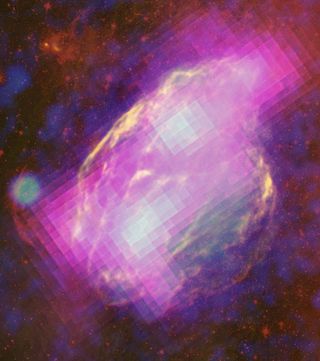
The W44 supernova remnant is nestled within and interacting with the molecular cloud that formed its parent star. Fermi's LAT detects GeV gamma rays (magenta) produced when the gas is bombarded by cosmic rays, primarily protons. Radio observations (yellow) from the Karl G. Jansky Very Large Array near Socorro, N.M., and infrared (red) data from NASA's Spitzer Space Telescope reveal filamentary structures in the remnant's shell. Blue shows X-ray emission mapped by the Germany-led ROSAT mission.
Ultra High-Energy Cosmic Rays
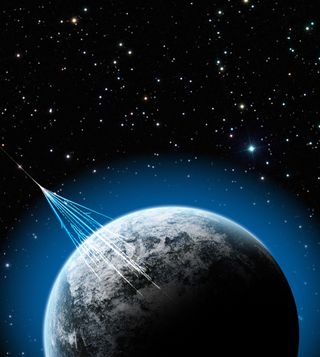
The origin of high-energy cosmic rays has been a 100-year astronomy mystery. But a study revealed on Feb. 14, 2013, unveiled conclusive proof that they are created in supernova explosions. See more photos here of the supernova discovery.
Supernova Remnant IC 443
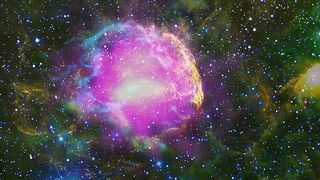
This multiwavelength composite shows the supernova remnant IC 443, also known as the Jellyfish Nebula. Fermi GeV gamma-ray emission is shown in magenta, optical wavelengths as yellow, and infrared data from NASA's Wide-field Infrared Survey Explorer (WISE) mission is shown as blue (3.4 microns), cyan (4.6 microns), green (12 microns) and red (22 microns). Cyan loops indicate where the remnant is interacting with a dense cloud of interstellar gas.
Artist's Illustration of a Supernova Explosion
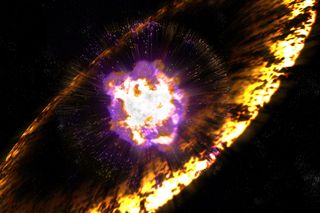
An artist's illustration of a supernova explosion, which sends off shock waves that accelerate protons to the point that they become cosmic rays, a process called Fermi acceleration. Many details of Fermi acceleration are unknown, but data from NASA's Fermi Gamma-ray Space Telescope provide overwhelming evidence that Fermi acceleration is responsible for cosmic rays. Image released Feb. 14, 2013.
W44 and IC 443, Two Supernova Remnants
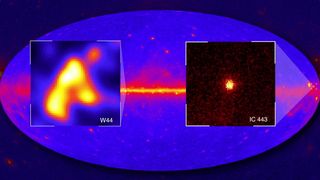
In order to understand the origin and acceleration of cosmic ray protons, researchers used data from the Fermi Gamma-ray Space Telescope, and targeted W44 and IC 443, two supernova remnants located thousands of light years away. Image released Feb. 14, 2013.
Spectra From Two Supernova Remnants
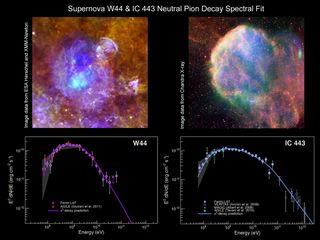
Finding evidence for the acceleration of protons has long been a key issue in the efforts to explain the origin of cosmic rays. This pair of spectra from two supernova remnants (also shown visibly with data from various satellites and wavelengths) are the "smoking gun" that researchers have been looking for. Image released Feb. 14, 2013.
Shock Front in the Remnant of the Supernova SN 1006

VLT/VIMOS observations of the shock front in the remnant of the supernova SN 1006 VLT/VIMOS observations of the shock front in the remnant of the supernova SN 1006 Click to Enlarge Very detailed new observations with ESO’s Very Large Telescope (VLT) of the remains of a thousand-year-old supernova have revealed clues to the origins of cosmic rays. The image on the left shows the entire SN 1006 supernova remnant, as seen in radio (red), X-ray (blue) and visible light (yellow). The second panel, corresponding to the small square region marked at the left, is a NASA/ESA Hubble Space Telescope close up view of the remarkably narrow region of the shock front, where the material from the supernova is colliding with interstellar medium. The third panel shows how the integral field unit of the VIMOS instrument splits up the image into many small regions, the light from each of which is spread out into a spectrum of its component colours. When these spectra are analysed, maps of the properties of the underlying object can be derived. The example shown here at the right is a map of one property of the gas (the width a spectral line), which is surprisingly variable, and implies, along with other indicators, the presence of very high-speed protons. Image released Feb. 14, 2013.
Get the Space.com Newsletter
Breaking space news, the latest updates on rocket launches, skywatching events and more!
Supernova SN 1006 Remnant
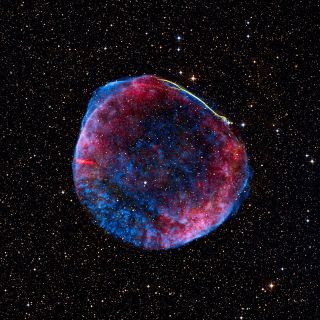
Another study announced on Feb. 14, 2013, studied the supernova SN 1006 to also find evidence of supernova shock waves that can accelerate cosmic rays. This remarkable image was created from pictures taken by different telescopes in space and on the ground. It shows the thousand-year-old remnant of the brilliant SN 1006 supernova, as seen in radio (red), X-ray (blue) and visible light (yellow). Image released Feb. 14, 2013.
Part of Supernova Remnant SN 1006
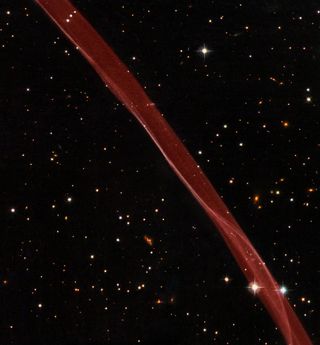
This image is a composite of hydrogen-light observations taken with Hubble's Advanced Camera for Surveys in February 2006 and Wide Field Planetary Camera 2 observations in blue, yellow-green, and near-infrared light taken in April 2008. The supernova remnant, visible only in the hydrogen-light filter was assigned a red hue in this color image. Image released Feb. 14, 2013.
Cosmic Rays Illustration
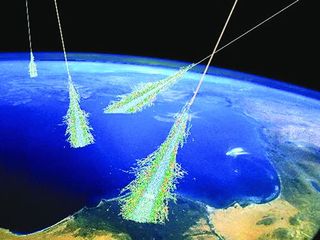
An artist's concept of the shower of particles produced when Earth's atmosphere is struck by ultra-high-energy cosmic rays.
Join our Space Forums to keep talking space on the latest missions, night sky and more! And if you have a news tip, correction or comment, let us know at: community@space.com.

Space.com is the premier source of space exploration, innovation and astronomy news, chronicling (and celebrating) humanity's ongoing expansion across the final frontier. Originally founded in 1999, Space.com is, and always has been, the passion of writers and editors who are space fans and also trained journalists. Our current news team consists of Editor-in-Chief Tariq Malik; Editor Hanneke Weitering, Senior Space Writer Mike Wall; Senior Writer Meghan Bartels; Senior Writer Chelsea Gohd, Senior Writer Tereza Pultarova and Staff Writer Alexander Cox, focusing on e-commerce. Senior Producer Steve Spaleta oversees our space videos, with Diana Whitcroft as our Social Media Editor.